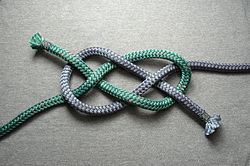(→Tying) |
m (W126jep moved page Adventist Youth Honors Answer Book/Knot/Carrick bend to AY Honors/Knot/Carrick bend without leaving a redirect: Part of translatable page "Adventist Youth Honors Answer Book/Knot/Carrick bend") |
||
| (89 intermediate revisions by 11 users not shown) | |||
| Line 1: | Line 1: | ||
| − | + | <noinclude><translate><!--T:5--> | |
| − | + | </noinclude> | |
| + | <!--T:6--> | ||
| + | {{ | ||
| − | + | <!--T:7--> | |
| − | + | Knot | |
| − | ' | + | | image=Knife-lanyard-knot-ABOK-787-Carrick-start.jpg |
| + | | image_caption=A fully interwoven diagonally opposed Carrick bend | ||
| + | | image2 = Carrick-bend-seized-ABOK-1439.jpg | ||
| + | | name=Carrick bend | ||
| + | | use = | ||
| + | The Carrick bend is used for joining two lines. It is particularly appropriate for very heavy rope or cable that is too large and stiff to easily be formed into other common bends. It will not jam even after carrying a significant load or being soaked with water. The Carrick bend's aesthetically pleasing interwoven and symmetrical shape has also made it popular for decorative purposes. | ||
| − | + | <!--T:2--> | |
| − | + | In the interest of making the Carrick bend easier to untie, especially when tied in extremely large rope, the ends may be seized to prevent the knot from collapsing when load is applied. This practice also keeps the knot's profile flatter and can ease its passage over capstans or winches. | |
| − | The | + | <!--T:3--> |
| + | The ends are traditionally seized to their standing part using a Round seizing. For expediency, a series of double constrictor knots, drawn very tight, may also be used. When seizing the Carrick bend, ''both'' ends must be secured to their standing parts or the bend will slip. | ||
| + | | image2 = Carrick-bend-seized-ABOK-1439.jpg | ||
| + | | warnings = The Carrick bend is generally tied in a flat interwoven form shown above. Without additional measures it will capsize (collapse) under load into a secure and stable, although bulky, form. If the knot is allowed to capsize naturally under tension, considerable slippage of line through the knot can occur before tightening. The knot should be upset carefully into the capsized form and worked up tight before actual use. | ||
| − | + | <!--T:8--> | |
| − | + | }} | |
| − | + | <!--T:9--> | |
| − | + | <noinclude></translate></noinclude> | |
| − | |||
| − | |||
| − | |||
| − | |||
| − | |||
| − | |||
Latest revision as of 14:04, 8 September 2021
| Carrick bend |
|---|
|
Use: The Carrick bend is used for joining two lines. It is particularly appropriate for very heavy rope or cable that is too large and stiff to easily be formed into other common bends. It will not jam even after carrying a significant load or being soaked with water. The Carrick bend's aesthetically pleasing interwoven and symmetrical shape has also made it popular for decorative purposes.
In the interest of making the Carrick bend easier to untie, especially when tied in extremely large rope, the ends may be seized to prevent the knot from collapsing when load is applied. This practice also keeps the knot's profile flatter and can ease its passage over capstans or winches. The ends are traditionally seized to their standing part using a Round seizing. For expediency, a series of double constrictor knots, drawn very tight, may also be used. When seizing the Carrick bend, both ends must be secured to their standing parts or the bend will slip.
WARNING: The Carrick bend is generally tied in a flat interwoven form shown above. Without additional measures it will capsize (collapse) under load into a secure and stable, although bulky, form. If the knot is allowed to capsize naturally under tension, considerable slippage of line through the knot can occur before tightening. The knot should be upset carefully into the capsized form and worked up tight before actual use.
|


